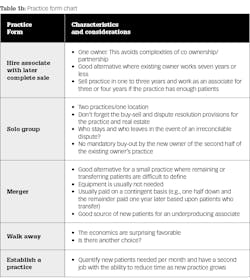Strategically assessing practice exit and entry choices: Part one
Editor's note: This is the first of a three-part series that discusses one of the two common elements of strategic planning for dentists. This first article covers practice exit and entry choices, the second will cover risk management, and the third will discuss the necessity for strategic planning by dentists.
Planning your practice exit and entry choice is crucial if you want to operate your practice your way throughout your career. If your practice is stable, you can grow it in a way that is consistent with your vision and ultimately depart when and how you choose to.
How you will eventually depart will dictate how you practice throughout your career, after you find the right practice opportunity for you. Hopefully, you will own or be an associate in a practice that allows you to provide quality services and remain passionate about your profession throughout your career.
But remember, if you don’t own your practice, you cannot significantly fund your retirement plan and you cannot sell what you don’t own. Worse yet, you will work for someone else.
Complete sale and purchase
A complete sale and purchase is simple. Except in very large practices, the practice owner can be paid in cash, and the tax treatment is favorable for both the seller and purchaser because asset treatment is attained. With asset treatment, the purchaser can deduct all assets purchased and the seller is taxed at primarily capital gains. A possible complexity is for practices operating as C corporations. These are double taxed unless an argument can be made for the use of personal goodwill, which is taxed at capital gains at one level. Advisors should follow the applicable case law.
Typically, a selling dentist works in the practice postsale for some period of time and for a specified number of hours per week. Generally, the term of the postsale employment and hours per week is within the new owner’s control.
The former owner will want the compensation to include both a productivity and administrative component. The former owner may want a provision that states that he or she will be scheduled much the same as before the sale. While the former owner may ask to be classified as an independent contractor, it is unlikely that he or she will pass the IRS, Department of Labor, or state tests to qualify as an independent contractor.
Co-ownership and partnership
Co-ownership and partnership are complex because there are three categories: the buy-in, the buy-out, and operations. While buy-in and buy-out categories are somewhat obvious, operations are not. Operations include allocation of compensation and overhead costs, decision-making control, and employment of family members as both doctors and staff. In addition, there are three business and tax structures: stock including goodwill, stock excluding goodwill, and the three-entity method.
There is a break-even point for the buy-in after the associate meets consistent performance standards. The associate does not incur a pay reduction to become an owner but can pay the purchase price within a measured period of time (e.g., not to exceed seven years).
The business and tax structure will dictate whether the purchase price will be increased or decreased to attain a tax-neutral fair-market value to balance the tax effects to the existing and new owners. For example, stock including goodwill is all capital gains to the existing owner and not deductible to the incoming owner. Therefore, the purchase price for the buy-in and formula for the future buy-out of the existing owner are decreased.
With stock excluding goodwill, the purchase price for the buy-in and formula for the future buy-out of the owner are increased. This is because the sale and purchase of goodwill is taxed as primarily ordinary income to the existing owner and should be increased again for an interest component. This primarily represents a pre-tax buy-in for the incoming owner due to the significant value of goodwill.
The three-entity method provides for asset treatment, so no increase or decrease to the tax-neutral fair market value is necessary. However, if the practice was formed before August 10, 1993, the anti-churning rules apply.1 The anti-churning rules provide that the goodwill is not deductible for either the buy-in or the buy-out if there is more than 20% ownership of a third entity, or if the dentists are related (e.g., parent and son or daughter). Yes, the anti-churning rules still apply and not following them risks “audit roulette.”2
Another challenge is that a junior owner may be unwilling to complete mandatory buy-out. In this case, the junior owner’s employment should terminate, he or she should receive very little back for the buy-out, and the junior owner should be subject to restrictive covenants. Co-ownership agreements should always include dispute resolution provisions once equal ownership is attained. For very large and group practices, meaningful minority ownership is vital, along with the ability to depart. There are numerous forms of co-ownership: private, corporate, or a combination.
Hire an associate with a later sale
Hiring an associate with a later complete sale provides for one owner and avoids the complexities of co-ownership. It is a good alternative if the existing owner plans to work seven years or fewer. The existing owner sells the practice in one to three years with asset treatment and is paid in cash. After the sale, the former owner works as an associate for three or four more years if the practice has a large enough patient load. If not, the former owner works on a limited basis and in the same capacity as in a complete purchase, and the post-sale employment is subject to the discretion of the new owner.
Solo group
A solo group is a combination of two or more practices in one location. Rather than purchase a 50% or pro rata interest in that practice, the associate purchases an undivided interest or one half of the tangible assets plus the goodwill attributable to the patients that the associate customarily treated. There is asset treatment, which means that the goodwill is deductible, even for practices formed before August 10, 1993, because there is no common ownership of more than 20% of a third entity.
There is usually no mandatory buy-out by the new owner of the second half of the existing owner’s practice. Because the existing owner maintains his or her practice, the owner can sell either to the new owner or to any other licensed dentist, subject to becoming a solo group member.
Like co-ownership, the buy-sell provisions (e.g., who stays and who leaves in the event of a dispute) are important, not only for the practice but for the real estate. Staff members can be shared, although this is not recommended. Each practice maintains its own health and retirement plans, and expenses are allocated either on a pro rata, productivity, or collection basis.
Merger
A merger is a good alternative if the patients who are anticipated to transfer to the purchasing practice are difficult to quantify (e.g., a small or otherwise unsalable practice). Equipment is usually not needed. The goodwill is calculated, and the selling dentist is often paid on a contingent look-back basis one year following closing with an initial down payment percentage (e.g., 50% of the anticipated or calculated goodwill).
If all patients transfer, the selling dentist is fully paid. If not, the purchasing practice pays only for the percentage of patients who do transfer. The goodwill rate for mergers is usually 35% of one year’s collections or a specified sum per transferring patient to the purchasing practice (e.g., $100 to $150 per patient). A merger of the practice can often be a good source of new patients for an underproducing associate, who is often a son or daughter joining a parent’s practice.
Walk away
The numbers work out surprisingly well when someone works one or two more years and then closes the doors. There may be no other choice in some geographic areas or for some specialty practices. If you saved for retirement, you need not worry about walking away.
Establish a practice
Most practices are established by an associate after he or she has held multiple associate positions, or if a specialist situation has not worked out. To establish a practice, one needs 30-plus new patients per month and a job elsewhere, with the ability to reduce the time in the second job. Here the strategic planning and budgeting processes are integral to securing financing and building the new practice.
Summary and thoughts
Operate your practice as a business. Do not take unnecessary tax risks. Ask to be bought out in cash. And don’t forget your other partner—the IRS. Above all, live your dreams at any age! Check Table 1 for a summary of many of these steps.
References
1. Internal Revenue Code. §197(f)(9).
2. American Bar Association Section of Taxation, Closely Held Businesses Committee. Section 197 and personal goodwill in professional practices. Panel discussion; May 10, 2019; Washington, D.C.
WILLIAM P. PRESCOTT, ESQ., EMBA, of Wickens Herzer Panza in Avon, Ohio, is a practice transition and tax attorney, and former dental equipment and supply general manager and representative. His most recent book, Joining and Leaving the Dental Practice, Third Edition, is available through the ADA Center for Professional Success. ADA members can download the e-book for free at success.ada.org/en/practice-management/ joining-and-leaving-the-dental-practice. For this and Mr. Prescott’s other publications, visit prescottdentallaw.com. Contact him at (440) 6958067 or [email protected].


